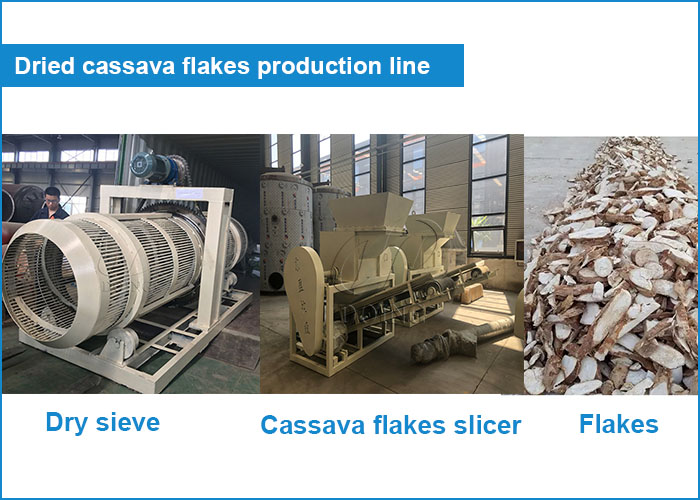Cassava flakes production line for cassava chips business
As the demand for animal feeds to grow, more and more businesses are turning to process dried cassava flakes as a solution, which not only can improve storage time but facilitate long-distance transportation. But what exactly is the process for producing cassava flakes? Now we will introduce you the dried cassava flakes production line for cassava chips business.
 Dried cassava flakes production line
Dried cassava flakes production line
Dried cassava flakes production line for cassava chips business:
The process of dried cassava flakes production line mainly consists of three parts: cleaning, slicing and drying. Fresh cassava roots firstly are put into a dry sieve for removing the impurities like muds, leaves, weeds, and so on attached on the surface of cassava roots in its rotating state. Then cleaned cassava roots enter the cassava flakes slicer. This slicing machine will evenly slice them into thin chips, whose thickness are adjustable. Finally, the thin cassava flakes will be dried by the sunlight or by a drying machine for the storage and transportation. Here is a 3D video of dried cassava flakes production line for cassava chips business:
The choice of dried cassava flakes slicer for cassava chips business:
The primary dried cassava flakes processing equipment for cassava chips business is the cassava flakes slicer, which comes in two types - roller and disk. The slice thickness can be adjusted according to the specific requirements of the business. Small farmers or processing workshops typically use small disk-type cassava slicers, while larger farms or processing plants opt for larger drum-type or disc-type slicers.
A large dried cassava flakes slicer consists of a main machine, coupling, motor, and diesel engine, with the main machine comprised of a knife head, upper and lower shell, and feed hopper, among other components. The knife head is responsible for cutting the material, and the thickness of the final slices can be adjusted by altering the distance between the knives. Generally speaking, the thickness of material slices produced by the slicer ranges from 10 mm to 20 mm, but it can be adjusted according to specific customer needs.
There are three key advantages to using a large dried cassava flakes slicer. First, it offers a high production capacity and efficiency, with processing rates ranging from 1 ton per hour up to 8 tons per hour, solving the problem of low efficiency associated with manual production. Second, it has a low material crushing rate and high production efficiency, making it a simple and easy-to-use piece of equipment that requires minimal maintenance.
With its enhanced shelf life, improved versatility, and increased economic viability, dried cassava flakes production has the potential to drive economic growth. If you want to invest in a dried cassava flakes production line for cassava chips business, welcome to contact us! We, Henan Jinrui, a professional manufacturer for cassava flakes processing machinery with over 10-year experience, can offer you the best configuration design based on your demand!
Tel/Whatsapp: +86-13526615783
Website: http://www.cassavaprocessing.com
Email: sales@doingmachinery.com
Address: 19B Kudirat Abiola Way Olusosun Bus stop, Ikeja, Lagos, Nigeria

Comments
Post a Comment
Hi,write down you message,and let's talk according the difference.